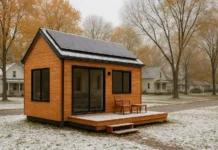20×20 Room Addition Cost in 2025: Homeowner Guide
Planning a 20×20 room addition in 2025 can feel overwhelming without a clear understanding of the true cost, required permits, and what’s included in the construction process. Whether you’re expanding your home with a family room addition, home office, or master suite, a well-planned project enhances comfort, functionality, and long-term property value.
In 2025, the average home addition cost continues to rise due to higher labor rates, evolving building codes, and increased material prices. That’s why setting a realistic budget and working with experienced home addition contractors is essential for success.
This guide breaks down everything you need to know about the cost to build a 20×20 room addition, including estimated cost, permit fees, and return on investment (ROI). You’ll learn how to plan confidently, stay within budget, and create the extra living space your family needs.
Before diving into pricing, let’s look at the major cost factors that shape every room addition project.
Understanding the True Cost of a 20×20 Room Addition
Every home addition project is different, but a few major factors always affect the overall price. Square footage, design complexity, and construction materials are the biggest influences on your total cost.
1. Design and Structural Factors
Your floor plan and type of addition determine price. A simple extra bedroom or family room addition costs less than a bathroom or kitchen that requires plumbing and electrical work. Homes needing structural changes or support beams raise project costs, while straightforward layouts save money.
2. Regional Labor and Material Pricing
Labor and material costs vary widely across the U.S. Urban areas like Los Angeles or San Francisco often face higher costs due to permit fees and contractor demand. Suburban regions may benefit from more affordable labor and materials.
3. Hidden and Additional Costs
Smaller but significant expenses—such as site preparation, insulation, or interior finishes—add up quickly. Including these early helps maintain accurate cost estimates.
4. Transparent Planning and Expert Guidance
Partnering with experienced professionals ensures every stage, from permits to completion, stays aligned with local building codes and budget goals.
Now that you understand the main cost drivers, let’s see how these translate into per-square-foot pricing.
Average Cost per Square Foot in 2025
Understanding cost per square foot helps homeowners estimate total investment before construction begins. In 2025, the home addition cost in 2025 varies depending on addition type, materials, and finishes.
National Cost Ranges
On average, a 20×20 room addition costs between $125 and $250 per square foot. Basic family room or bedroom additions sit at the lower end. Bathrooms, kitchens, or home offices—requiring plumbing, wiring, or HVAC upgrades—cost more. Premium finishes can push totals toward the high end.
How Square Footage Impacts Budget
A 20×20 room equals 400 sq ft. Even a small size change affects your total cost; adding 50 square feet can raise expenses by $6,000–$12,000 depending on labor and material rates.
Material and Labor Balance
Construction costs typically split 50/50 between materials and labor. Choosing durable roofing, energy-efficient insulation, and quality interior finishes increases upfront spending but reduces long-term maintenance.
Regional Variation
Areas with strict building codes, high permit costs, or extreme climates—like coastal or cold zones—often see elevated prices due to specialized materials and regulations.
Once you know your average cost range, it’s helpful to see what that investment actually covers.
What’s Included in a 20×20 Room Addition Project
A well-planned home addition project includes multiple phases that collectively determine your total construction expense.
- Foundation and Framing: Involves excavation, crawl space or new foundation, and structure alignment with your existing structure.
- Roofing and Insulation: Protects against weather while improving energy efficiency.
- Electrical Work, Plumbing, and HVAC System: Includes lighting fixtures, water lines, and air circulation systems.
- Interior Finishes: Paint, flooring, and trim complete your new space.
- Final Inspection: Confirms compliance with local building codes and safety rules.
Each stage adds measurable value to your home and influences your final cost.
Each construction phase plays a role in cost, but the type of room you choose has the biggest impact overall.
Room Type Cost Comparison

The type of room you add plays a major role in your overall cost, square footage planning, and future property value. Each home addition project carries unique design demands, construction costs, and long-term benefits. Below is a breakdown of how different room types compare in 2025.
Bedroom Addition
A 20×20 bedroom addition cost is one of the most affordable ways to expand your home. It typically includes basic construction materials and minimal structural changes. However, upgrading to a master suite addition with a walk-in closet, bathroom, or primary suite layout can raise the total cost but significantly improve your home’s value. This type of addition is ideal for a growing family or homeowners looking for more privacy and comfort.
Family Room Addition
A family room addition adds livable square footage without the need for plumbing or extensive electrical work. This room addition project offers one of the highest returns on investment because it enhances comfort and boosts home value with a relatively low-cost construction plan.
Bathroom or Master Suite Addition
Adding a bathroom addition or primary suite involves detailed plumbing work, HVAC system updates, and high-end finishes. While this option increases the cost per sq ft, it delivers exceptional convenience and long-term property value growth.
Kitchen or Dining Addition
A kitchen or dining room addition typically has the highest construction costs because it includes electrical wiring, plumbing work, and premium interior finishes. Although expensive, this home improvement project offers one of the strongest boosts to home value and energy efficiency in 2025.
Beyond room type, several other elements can influence your total budget and project timeline.
Major Factors That Influence Cost
Key cost factors shape the overall cost of a home addition project:
- Location and Labor Rates: Metro areas have higher costs; smaller towns often enjoy low-cost labor.
- Material Choices and Quality: Premium construction materials or exterior finishes raise expense but increase durability.
- Structural Changes and Foundation Work: Reinforcing your existing structure or adding a new foundation increases total cost.
- Utilities and Systems: Electrical wiring, plumbing, and HVAC system design affect price.
- Design Complexity: Custom layouts, vaulted ceilings, or high-end finishes raise construction costs.
- Site Preparation: Clearing trees or adjusting slope adds to additional costs and timeline.
After identifying the main influences, it’s time to put those details into a structured project budget.
Budgeting and Estimating the Total Cost
To create a realistic budget, start with a cost calculator or HomeAdvisor tool to gauge average rates in your region.
1. Define Your Budget
Use cost per square foot addition as your baseline, then add 10–15% as a contingency for unexpected additional costs.
2. Break Down Expenses
- Labor and Permits: Contractor, building permit, and inspection fees
- Materials: Lumber, drywall, roofing materials, and insulation
- Utilities: Electrical work, plumbing, and HVAC system
- Finishes: Paint, trim, lighting fixtures, and flooring
3. Get Multiple Estimates
Collect at least three cost estimates from licensed home addition contractors. Comparing bids clarifies transparency and prevents surprises.
4. Prioritize Long-Term Value
Investing in energy efficiency upgrades, high-end materials, or better insulation increases home’s value and cuts long-term bills.
Once your budget is set, the next step is ensuring your project complies with all legal and safety standards.
Permits, Codes, and Legal Requirements
Before construction begins, you’ll need the right building permit to comply with local building codes.
- Permits Protect Homeowners: They confirm safety, structural soundness, and code compliance.
- Local Codes Vary: Some regions regulate square footage limits, setbacks, and energy efficiency standards.
- Inspections and Approvals: City inspectors review framing, wiring, and plumbing work at each stage.
- Peace of Mind: Proper permits protect your home’s value and simplify insurance or resale processes.
With permits handled, the next major decision is whether to take a DIY approach or hire professionals.
DIY vs. Hiring Professional Contractors
When planning a 20×20 room addition in 2025, many homeowners wonder whether to handle it themselves or hire professional home addition contractors. Both choices affect your total project cost, timeline, and overall construction quality.
DIY Approach
A DIY room addition may seem cost-effective, but it involves complex steps such as framing, plumbing work, and electrical wiring that require technical skill. Even small mistakes can raise costs or create safety issues.
Key challenges include:
- Incorrect plumbing or wiring that leads to expensive repairs.
- Missing building permits or failed inspections that delay progress.
- Structural errors that reduce safety and resale value.
DIY efforts work best for minor finishing tasks—like painting, landscaping, or installing trim—but not for large-scale home additions.
Professional Contractors
Hiring licensed builders ensures your project meets local codes and high construction standards. Professionals manage everything—from planning and permits to inspections and completion—saving time and avoiding costly rework.
Key benefits include:
- Complete management of permits, scheduling, and inspections.
- Consistent quality control and adherence to regulations.
- Predictable total project cost and on-time completion.
Working with professionals delivers expertise, safety, and peace of mind—ensuring your 20×20 room addition is built efficiently and adds lasting value.
Even when hiring contractors, there are still smart strategies to manage costs effectively.
Ways to Save Money on a Room Addition
- Plan Early – Detailed designs and careful planning prevent budget overruns.
- Compare Quotes – Get multiple bids to spot fair construction costs.
- Simplify Design – Avoid unnecessary structural changes or roofline adjustments.
- Use Cost-Saving Materials – Engineered wood or local building materials lower expenses.
- DIY Finishes – Handle painting or landscaping yourself to cut labor rates.
- Focus on Energy Efficiency – Invest in insulation and windows that reduce long-term bills.
These strategies keep your total cost manageable without sacrificing quality or home’s value.
After managing costs and construction, let’s explore how your investment can pay off in long-term value.
Impact on Property Value and Return on Investment (ROI)

A 20×20 room addition adds both valuable square footage and long-term equity. On average, homeowners recover 60–75% of their construction costs through increased property value.
Rooms That Add the Most Value:
- Master Suite or Family Room Addition – Delivers high comfort, functionality, and excellent ROI.
- Home Office – Appeals strongly to remote workers and modern buyers, improving resale potential.
Key Buyer Appeal Factors:
- Updated HVAC system, modern floor plan, and cohesive design with the existing home.
- Durable interior finishes and energy-efficient quality materials that lower maintenance costs.
Professionally managed home addition projects yield the best ROI because they meet local building codes, ensure structural integrity, and elevate your home’s overall market appeal.
Overall, a 20×20 room addition remains one of the most valuable upgrades for homeowners seeking both functionality and financial return.
Still have questions about costs, permits, or timelines? Here are some common homeowner questions answered.
Frequently Asked Questions (FAQs)
Q: How much does a 20×20 room addition cost in 2025?
A: It typically ranges from $80,000 to $200,000, depending on construction materials, labor rates, and project size.
Q: Do I need a building permit?
A: Yes. Every home addition project requires one to meet local building codes and protect your home’s value.
Q: How long does construction take?
A: Most projects last 3–6 months depending on weather and complexity of the project.
Q: Will this increase property taxes?
A: Possibly, since your home value and square footage rise.
Q: Is DIY cheaper?
A: Not usually. Professional Home Addition Contractors ensure safety, permits, and quality work that protects your significant investment.
Now that you have a full picture of the process, cost, and ROI, let’s close with some final guidance for planning success.
Final Words
A 20×20 room addition in 2025 offers a practical way to expand your home and enhance daily living. Success begins with thoughtful planning—covering design, permits, budgeting, and construction scheduling. Careful preparation helps avoid delays, unexpected costs, and design compromises.
Working with trusted home addition contractors ensures your project meets code, stays on schedule, and reflects your vision. Whether you’re building a relaxing master suite, a spacious family room, or a functional home office, a well-executed room addition enhances your home’s functionality, long-term value, and overall satisfaction.
Want more expert insights on home addition costs, home renovation trends, and property value tips?
Visit Redfinz.com — where smart homeowners begin their planning journey.






